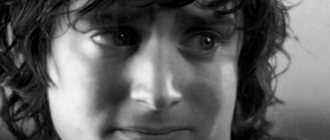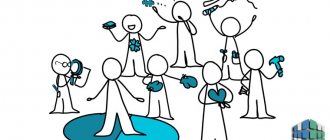Continuing the topic of personality typology, let me remind you that accentuation is a pronounced character trait that does not go beyond the norm of deviations in human psychology and behavior. Accentuation manifests itself to the greatest extent in certain unfavorable life circumstances for a person. This influences a person’s behavior and attitude towards others.
In the previous article, I described the classification of A. E. Lichko and mentioned that it is consonant with the classification of K. Leonhard, a German scientist and psychiatrist, they seem to complement each other. I will dwell on it in more detail.
Types of character accentuation according to K. Leonhard
Karl Leonhard (1904 – 1988)
The classification is based on an assessment of a person’s communication style with the outside world.
Stuck (rigid) type
Moderately sociable, prone to moralizing, taciturn. In conflicts, such a person usually acts as the initiator. Sensitive to social justice. He strives to complete the task he undertakes with high quality, to achieve high performance in any activity, placing increased demands on himself. Ambitious, jealous, sometimes overly arrogant. At work he places increased demands on his subordinates, and in the family he is also unreasonably demanding.
Excitable
It is characterized by low contact in communication, slowness of verbal and non-verbal reactions. They are often gloomy, boring, prone to abuse and conflicts, in which they themselves are an active and provocative party. They are very domineering in the family and discourteous in the team. If they are in a calm emotional state, they are conscientious and careful, they love animals and small children. However, in a state of emotional arousal, they have poor control over their behavior, are irritable and hot-tempered.
Demonstrative
Sometimes this type is called hysterical. People of this type easily establish contacts, strive for leadership, love power and praise. They quickly adapt to people, but are prone to intrigue, despite their outward softness. They irritate those around them with their self-confidence and high level of aspirations. As a rule, they themselves provoke conflicts, but at the same time actively defend themselves. People of this type are artistic, courteous, and extraordinary in their thinking and actions. People are repulsed by their negative traits: boasting, shirking from work, hypocrisy, selfishness.
Pedantic
Conscientious, serious, reliable, careful. They rarely enter into conflicts. At work, they make numerous formal demands on team members and behave like bureaucrats. Their formalism and grumbling greatly irritate those around them. The family is overly demanding of neatness and order.
Hyperthymic
Characterized by excessive contact and talkativeness. This type has pronounced gestures, facial expressions and pantomime. During communication, they deviate from the topic or change it. They don't tolerate comments. They are proactive, energetic, full of optimism, and thirst for activity. However, they are often instigators of conflicts, frivolous, and do not always conscientiously treat their responsibilities. They do not like loneliness, strict discipline and monotonous work.
Disthymic
He is characterized by low contact, taciturnity, and a dominant pessimistic mood. They are usually homebodies, avoid noisy companies and parties, and lead a secluded lifestyle. Easily enter into conflicts. Endowed with a thorough instinct, serious, conscientious. They have a keen sense of justice. The dysthymic type is characterized by slow thinking, passivity, clumsiness, and individualism.
Cycloid (cyclothymic, affectively labile, unstable)
Cycloids are characterized by frequent mood swings and arrogance in dealing with people. During periods of high mood, they are sociable; during periods of depressed mood, they are withdrawn. During times of elation, they behave like people with hyperthymic accentuation of character, and during periods of decline, they behave like people with dysthymic accentuation.
Exalted (affectively exalted)
People of this type are characterized by high contact, amorousness, and talkativeness. They often argue, but do not lead to open conflicts; in a dispute they can be both an active and passive party. They value their loved ones and friends, are very attached and attentive to them. They are prone to compassion, altruistic, have good taste, and are able to show bright and sincere feelings. Their negative traits: commitment to momentary moods, alarmism.
Anxious
This type is characterized by low contact, timidity, lack of self-confidence, and a minor mood often dominates. They rarely enter into conflicts with people, playing only a passive role in them. They are often targets of ridicule and scapegoats. They are friendly, self-critical, and efficient.
Emotive
People with this type of character accentuation prefer to communicate with a narrow circle of select people whom they understand perfectly. They play a passive role in conflicts and try to avoid them. They are touchy, but they carry grievances within themselves. Overly sensitive and tearful. They have concentration, a heightened sense of duty, and diligence.
Extroverted
They are distinguished by high contact, they have many friends and acquaintances. They are talkative, even chatty, and open to any information. They do not occupy leading positions in communication; they prefer to obey and be in the shadows. Performers are always ready to listen carefully to others. Negative traits: susceptibility to influence, thoughtlessness of actions, frivolity, passion for entertainment, prone to spreading rumors and gossip.
Introverted
They are characterized by very low contact, isolation, isolation from reality, and a tendency to philosophize. They conflict only in cases where others interfere in their personal lives. They love loneliness. They are principled, reserved, and have strong convictions. However, they are stubborn, rigid in their thinking, and tend to stubbornly defend their point of view or ideas, no matter what.
Depending on the degree of expression, we, together with A. A. Aleksandrov, identified two degrees of character activation—explicit and hidden [Pathological disorders..., 1973].
Explicit accentuation. This degree refers to extreme variants of the norm. Here there are fairly constant traits of a certain type of character. A carefully collected anamnesis, information from loved ones, short observation, especially among peers, as well as the results of an examination using the “Pathocharacterological Diagnostic Questionnaire...” (1976) make it possible to recognize this type. However, the severity of traits of a certain type usually does not prevent satisfactory social adaptation. The position occupied, as a rule, corresponds to abilities and capabilities. In adolescence, character traits often become sharper, and under the influence of psychogenic factors that address the “place of least resistance,” temporary disturbances in social adaptation and behavioral deviations may occur. As one grows up, character traits either remain quite pronounced, but are compensated and do not interfere with adaptation, or are smoothed out so much that obvious accentuation becomes hidden.
Hidden accentuation. This degree should not be classified as extreme, but as normal variants of the norm. In ordinary, familiar conditions, the traits of any type of character are weakly expressed or do not appear at all. Even with prolonged observation, varied contacts and detailed acquaintance with the biography, it is difficult to form a clear idea of a certain type. However, traits of this type can clearly, sometimes unexpectedly, manifest themselves under the influence of those situations and mental traumas, which again place increased demands on the “place of least resistance.” Psychogenic factors of a different kind, even severe ones, not only do not cause mental disorders, but may not even reveal the type of character. If such traits are detected, then, as a rule, this does not lead to noticeable social maladjustment.
Basic types of character accentuations
Two classifications of types of accentuations have been proposed - the first was created by K. Leonhard (1968) and modified in the new edition of his book (1976), the second was developed by us [Lichko A. E., 1977]. A comparison of these classifications is given below.
| Types of character accentuations according to our classification | Types of accentuated personalities according to K. leonhard (1976) |
| Hyperthymic | Hyperthymic |
| Cycloid | Affectively labile |
| Labile | Affectively exalted |
| Same | Emotive |
| Asthenoneurotic | — |
| Sensitive | Anxious (fearful) |
| Psychasthenic | Pedantic |
| Schizoid | Introverted |
| Epileptoid | Excitable |
| Hysterical | Demonstrative |
| Unstable | — |
| Conformal | — |
| Conformal-hyperthymic variant of conformal | Extroverted |
| — | Stuck |
| — | Dysthymic |
K. Leonhard’s classification does not include the unstable and conformal types, which are quite common in adolescence, as well as the asthenoneurotic type. The dysthymic type in his classification corresponds to the constitutional-depressive type according to P. B. Gannushkin (1933), and the stuck type corresponds to the paranoid type. Both of them practically never meet in adolescence.
Our classification is intended for adolescence - the types presented in it are described below.
Hyperthymic type. Teenagers belonging to this type are distinguished from childhood by great noisiness, sociability, excessive independence, even courage, and a tendency to mischief. They have neither shyness nor timidity in front of strangers, but they lack a sense of distance in relation to adults. In games they like to command their peers. Teachers complain about their restlessness. At school, despite good abilities, a lively mind, the ability to grasp everything on the fly, they study unevenly due to restlessness, distractibility, and lack of discipline.
In adolescence, their main feature is almost always a good, even somewhat upbeat mood. It is combined with good health, often a flourishing appearance, high vitality, activity and bursting energy, always a wonderful appetite and sound, refreshing sleep. Only occasionally is the sunny mood darkened by outbursts of irritation and anger caused by the opposition of others, their desire to suppress the teenager’s too vigorous energy, to subordinate him to their will. The emancipation reaction has a strong impact on behavior: such adolescents show independence and independence early. They react extremely violently to hyperprotection on the part of parents and educators with its petty control, everyday care, moralizing and instructions, “working through” for minor offenses, especially in front of peers. They do not tolerate strict discipline and strictly regulated regimes. But in unusual situations they do not get lost, they show resourcefulness, they know how to catch and dodge. They treat rules and laws lightly; they may, unnoticed by themselves, overlook the line between what is sometimes permitted and what is always prohibited.
character accentuations – previous | next – hyperthymic teenagers
Adolescent psychiatry. Content.
Positive and negative traits of dysthymic children
Closedness is the most basic problem of such individuals. During the conversation they mostly remain silent. Only a pause that is too long can force them to express their opinion.
When troubles happen in life, dysthymic children experience them very hard. Why? They carry all negative thoughts within themselves, rarely sharing their feelings with others. As a result, they develop a pessimistic mindset, which leads to deep depression.
At the same time, the positive aspects of dysthymic individuals include:
- conscientious attitude to work;
- high morality;
- a heightened sense of justice;
- accuracy and scrupulousness;
- tact;
- lack of selfishness.
Thanks to their perseverance, diligence and diligence, they reach extraordinary heights in their careers. This applies only to those activities where energy, sociability and speed in decision making are not needed. Although such teenagers are often offended, they still do not give vent to their feelings. They maintain good relationships with teachers and peers because these students always occupy socially desirable positions.
IMPORTANT! The positive side of dysthymic temperament is the formation in the child’s mind of a serious ethical and moral position. Such children always take into account the feelings of others, so it is easy to raise them into full-fledged members of society.










